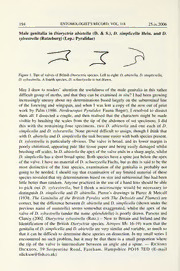
Male genitalia in Dioryctria abietella (D. & S.), D. simplicella Hein. and D. sylvestrella (Ratzeburg) (Lep.: Pyralidae) PDF
Preview Male genitalia in Dioryctria abietella (D. & S.), D. simplicella Hein. and D. sylvestrella (Ratzeburg) (Lep.: Pyralidae)
194 ENTOMOLOGIST'SRECORD,VOL. 118 25.ix.2006 Male genitalia in Dioryctria abietella (D. & S.), D. simplicella Hein, and D. sylvestrella (Ratzeburg) (Lep.: Pyralidae) Figure 1.TipsofvalvesofBritishDioryctriaspecies.Lefttoright:D. abietella, D. simpliciella, D. sylvestrella. Afourthspecies,D. schuetzeellaisnotdrawn. May I draw to readers’ attention the usefulness of the male genitalia in this rather difficult group ofmoths, and that they can be examined in situl I had been growing increasingly uneasy about my determinations based largely on the subterminal line of the forewing and wingspan, and when I was lent a copy of the now out ofprint work by Palm (1986. Nordeuropas Pyralider. Fauna Bpger), I resolved to dissect them all. I dissected a couple, and then realised that the characters might be made visible by brushing the scales from the tip of the abdomen of set specimens. I did this with the remaining four specimens, two D. abietella and one each of D. simplicella and D. sylvestrella. None proved difficult to assign, though I think that withD. abietella andD. simplicella thetaskbecameeasierwithboth speciespresent. D. sylvestrella is particularly obvious. The valve is broad, and its lower margin is poorly chitinized, appearing pale like tissue paper and being easily damaged whilst brushing offscales. InD. abietella the apex ofthe valveends in asharp angle, whilst D. simplicella has a shortbroad spine. Both species have a spinejustbelow the apex ofthe valve. I have no material ofD. schuetzeella Fuchs, but as this is said to be the most distinctive of the four species, examination of the genitalia is probably not going to be needed. I should say that examination of my limited material of these species revealed that my determinations based on size and subterminal line hadbeen little better than random. Anyone practiced in the use ofa hand lens should be able to pick out D. sylvestrella but I think a microscope would be necessary to distinguish D. simplicella and, D. abietella. Pierce’s drawings in Pierce & Metcalf (1938. The Genitalia ofthe British Pyrales with The Deltoids and Plumes are ) correct, but the difference between D. abietella andD. simplicella (shown underthe previous name of mutatella) seems somewhat exaggerated, whilst the apex of the valve ofD. sylvestrella (under the name splendidella) is poorly drawn. Parsons and Clancy (2002. Dioryctria sylvestrella (Ratz.) - New to Britain and Ireland and the Identification of the British Dioryctria species. Atropos 15: 16-19) warn that the genitaliaofD. simplicella andD. abietella are very similarand variable, so much so that it can be difficult to determine these species on dissection. In my small series I encountered no such problem, but it may be that there is a small propo—rtion where the tip of the valve is intermediate between an angle and a spine. Richard Dickson, 39 Serpentine Road, Fareham, Hampshire P016 7ED (E-mail [email protected]).
